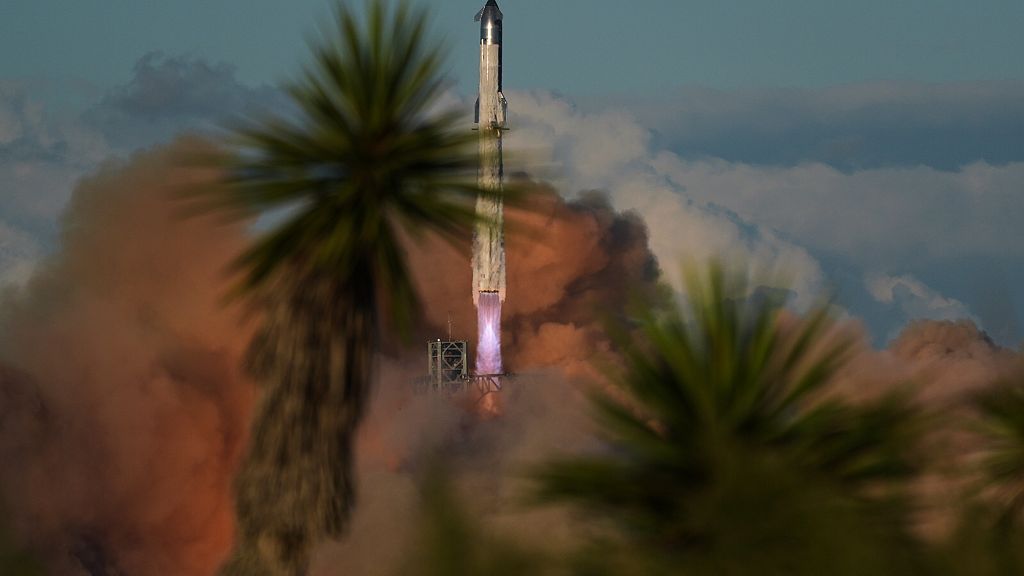
SpaceX’s Starship rocket successfully launched from Texas last week for its 11th test flight, marking a significant milestone for the company. However, industry experts caution that the rocket still has significant hurdles to overcome before it can be deemed ready for ambitious space exploration projects.
During the test, the spaceship’s booster fired all 33 of its engines to propel the Starship into the air. As it ascended, it ignited another six engines to breach Earth’s atmosphere, according to SpaceX, the company owned by Elon Musk. Once in space, the Starship released eight mock SpaceX satellites and restarted one of its engines.
Challenges Ahead for SpaceX’s Starship
The Starship, touted as the most powerful rocket ever built, is slated for use in the United States’ Artemis III mission in 2027. This mission aims to return humans to the Moon’s surface for the first time since the Apollo missions of the 1960s. Eventually, SpaceX plans to use the Starship for both lunar and Mars missions in the 2030s.
Despite the successful launch, space industry experts highlight numerous technical milestones that SpaceX must achieve before it can transport humans to the Moon. Lars Petzold, a research fellow at the European Science Policy Institute (ESPI), emphasized the urgency of these developments.
“There’s a lot of things that SpaceX still needs to prove and they are, of course, very cautious because the time is basically running out for them,” Petzold said.
Incremental Progress and Suborbital Limitations
Starship is being developed for three concurrent missions: deploying Starlink satellites, the Artemis III lunar missions, and eventual Mars exploration. Petzold noted that SpaceX is using these test flights to incrementally build its capabilities. The company may next attempt to demonstrate the craft’s ability to achieve orbit, as all previous launches have been suborbital.
Pierre Lionnet, managing director of the professional space industry association ASD-Eurospace, pointed out that remaining suborbital limits Starship’s ability to deploy satellites into orbit, a key operational goal.
“I expected to see it on the second or third launch,” Lionnet said. “Usually when you test a launcher you test it … to put satellites in orbit. Nobody cares about anything else a launcher does.”
Technical Hurdles: Refueling and Reusability
Once SpaceX achieves orbit, it must demonstrate the ability to transfer propellant between vessels, a critical capability for Moon or Mars missions. Petzold described this as a “crucial” part of the process, as the ship will require additional fuel for long-distance travel.
“Moving liquid gas between two bodies in space is a major feat that has never been done before,” Lionnet said. “Here we are talking about moving literally hundreds of tonnes of those fluids from one starship to the other in order to fill it up.”
The reusability of the Starship is another aspect under scrutiny. While SpaceX has successfully demonstrated rapid turnaround times for its Falcon 9 booster, the upper portion of the Starship faces harsher conditions upon re-entry, necessitating more extensive servicing.
“If you look at the videos of those Starships coming back to Earth, they are covered in flames … it seems really burned and scarred looking at it,” Lionnet noted. “It’s very difficult to believe that the same item could be put back to launch immediately.”
Future Developments: Starship Version 3
SpaceX spokesperson Dan Huot announced during the webcast of the 11th flight that a new Version 3 model of the Starship is in development. This model will feature significant changes to enable mass production and satellite launches.
Among the upgrades are propulsion and energy modifications designed to support longer missions. The new model will also include docking adapters for propellant transfer between two Starship capsules.
Huot stated, “A new fuel transfer tube for Starship will have ‘a rocket inside of a rocket’ that will give SpaceX a faster way to start all 33 of its engines at the same time.”
For Petzold, the advancements in Version 3 signify a move towards the “operational use” of the Starship, potentially allowing it to deploy Starlink satellites. However, the craft remains far from ready for the highly anticipated Moon or Mars missions.
As SpaceX continues to develop and test its Starship, the clock is ticking. The company’s ability to meet the 2027 deadline for the Artemis III mission will depend on the success of future tests and the resolution of existing technical challenges.






